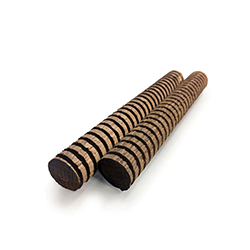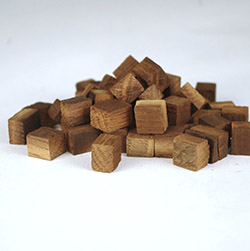Which Oak Works Best for Your Wine? Everything You Need to Know
Posted by Matteo Lahm on 13th Apr 2025
The art of winemaking is a delicate dance between science and creativity, and the use of oak is no exception. As a home winemaker, you have the power to shape your wine's character, and understanding the nuances and flavor profiles of various types of oak can elevate your creations to new heights. In this article, we will delve into the world of oak, exploring the chemical compounds that impart unique flavors and identifying which types of oak work best with different wines. So, grab your metaphorical paintbrush, and let's begin our journey into the oak embrace.
The Chemistry:
Oak's influence on wine is primarily due to the extraction of various chemical compounds during the aging process. These compounds can be broadly categorized into three groups: volatile phenols, oak lactones, and tannins.
1. Volatile Phenols: These compounds are responsible for the spicy, smoky, and toasty flavors often associated with oak-aged wines. The most notable volatile phenol is guaiacol, which imparts a smoky, bacon-like aroma. Another important compound is eugenol, which contributes to the spicy, clove-like character.
2. Oak Lactones: These compounds are responsible for the sweet, vanilla, and coconut flavors in wine. The two primary oak lactones are cis- and trans-oak lactone, with cis-oak lactone being the more potent of the two, imparting a stronger coconut aroma.
3. Tannins: Tannins are polyphenolic compounds that contribute to the astringency, mouthfeel, and structure of wine. They can also act as antioxidants, protecting the wine from oxidation and enhancing its aging potential.
The Oak Types and Their Flavors:
Now that we've covered the chemistry, let's explore the different types of oak and the flavors they impart. There are two main species of oak used in winemaking: Quercus Alba (American oak) and Quercus Robur (European oak).
1. American Oak: Known for its assertive flavors, American oak imparts strong vanilla, coconut, and dill notes to wine. The wider grain of American oak allows for faster extraction of flavors, making it a popular choice for bold, full-bodied wines like Cabernet Sauvignon and Zinfandel.
2. European Oak: European oak, which includes French, Hungarian, and Slavonian oak, is generally more subtle and imparts a greater variety of flavors. French oak, for example, is known for its delicate toast, spice, and nutty flavors, making it perfect for elegant wines like Pinot Noir and Chardonnay. Hungarian and Slavonian oak, on the other hand, offer a balance between the boldness of American oak and the subtlety of French oak and are widely used with Sangiovese.
Matching Oak with Wine:
As a home winemaker, you have the freedom to experiment with different oak types and toast levels to find the perfect match for your wine. Here are some general guidelines to help you make the right choice:
1. Bold, full-bodied red wines: These wines, such as Cabernet Sauvignon, Merlot, and Zinfandel, can benefit from the assertive flavors of American oak or the balanced character of Hungarian and Slavonian oak.
2. Light, elegant red wines: For wines like Pinot Noir and Grenache, the subtle flavors of French oak can enhance their delicate fruit and earthy notes without overpowering them.
3. White wines: Chardonnay is the most common white wine aged in oak, with French oak being the preferred choice for its subtle, toasty flavors. However, some winemakers also experiment with American oak for a bolder, more tropical profile.
4. Wines to avoid Oaking: Some wines, such as Sauvignon Blanc, Riesling, and most rosés, are best enjoyed unoaked to preserve their bright, fruity, and refreshing character. For the reds, Barbera is also a holdout. Barbera is known for its bright, fresh fruit flavors, such as cherry, raspberry, and blackberry, along with its high acidity. The use of oak can sometimes mask or overpower these fruity characteristics, which are the hallmark of Barbera wines. By avoiding or minimizing oak aging, winemakers can preserve the vibrant fruitiness and crisp acidity that make Barbera so appealing.

Toasting the Oak: A Symphony of Flavors
In addition to the type of oak, the toasting level plays a crucial role in shaping the flavors and aromas imparted to your wine. Toasting refers to the process of heating the oak barrels or oak alternatives (such as chips, staves, or cubes) to varying degrees, which alters the chemical composition and releases different compounds. Think of toasting as the conductor of an orchestra, guiding the symphony of flavors to create a harmonious balance in your wine.
Toasting levels can be broadly categorized into light, medium, and heavy, each with its unique impact on the wine:
1. Light Toast: Lightly toasted oak imparts subtle, delicate flavors to the wine. At this level, the oak lactones are more pronounced, contributing to the sweet, vanilla, and coconut notes. Additionally, light toast allows for the preservation of the oak's natural tannins, which can enhance the wine's structure and mouthfeel. This toasting level is well-suited for wines with delicate fruit flavors, such as Pinot Noir and Chardonnay, where a gentle touch of oak can complement the wine without overpowering it.
2. Medium Toast: As the toasting level increases, the oak's volatile phenols become more prominent, introducing a greater variety of flavors. Medium toast imparts a balance of vanilla, toast, and spice notes, along with a hint of caramel and a moderate tannin structure. This versatile toasting level works well with a wide range of wines, from elegant reds like Merlot and Cabernet Franc to richer white wines like Chardonnay and Viognier.
3. Heavy Toast: At this level, the oak's volatile phenols take center stage, creating bold, smoky, and roasted flavors. Heavy toast introduces intense notes of espresso, dark chocolate, and charred wood, along with a softer tannin structure due to the breakdown of tannins during the toasting process. This toasting level is ideal for robust, full-bodied wines like Cabernet Sauvignon, Zinfandel, and Syrah, which can stand up to the powerful flavors imparted by heavily toasted oak. All this aside, it is also very important to note that heavy toast oak should still be used with caution. Heavy toast oak packs quite the punch so unless you really love the dominant flavors it will impart, you still might want to stick with medium toast.
Heavy toast is often preferred for aging whiskeys and bourbons, as it imparts bold, rich flavors that complement the spirit's character. The process of heavy toasting breaks down the wood's cellulose and hemicellulose, releasing compounds that contribute to the development of complex flavors and aromas that can be overwhelming in wine.
Conclusion:
The world of oak is vast and full of possibilities, and as a home winemaker, you have the unique opportunity to explore and experiment with this powerful ingredient. By understanding the chemistry behind oak's influence and selecting the right type for your wine, you can create a masterpiece that is truly your own. So, embrace the oak, and let it guide you on your winemaking journey.



